Redox Reactions: Oxidation & Reduction, Oxidation Number | Science & Technology for UPSC CSE PDF Download
What are Redox Reactions?
A redox reaction occurs when atoms alter their oxidation numbers within a chemical reaction. This involves some atoms losing electrons, which is oxidation, and others gaining electrons, known as reduction. As both processes happen concurrently, the term "redox" is derived from the combination of reduction and oxidation.
Classical Concept of Oxidation and Reduction
The term oxidation was first used to describe chemical reactions in which oxygen was added to an element of a compound. The phenomenon of combustion was the earliest example of oxidation. Later on, the term oxidation was extended to describe many more reactions that occurred without the use of even oxygen.

Oxidation- According to the classical concept
A substance that brings oxidation is known as an oxidizing agent. In simple terms, "oxidation" means adding oxygen or an electronegative element to something or taking away hydrogen or an electropositive element from it.
(i) Addition of Oxygen: Reduction is a chemical reaction in which oxygen is removed from any chemical species (atom, ion, or molecule).
2Mg + O2 → 2MgO
S + O2 → SO2
2CO + O2 → 2CO2
Na2SO3 + H2O2 → Na2SO4 + H2O
(ii) Removal of Hydrogen: Oxidation is a chemical reaction in which hydrogen is removed from any chemical species (atom, ion, or molecule).
H2S + Cl2 → 2HCl + S
4HI + O2 → 2H2O + 2I2
4HI + MnO2 → MnCl2 + 2H2O + Cl2
(iii) Addition of an Electronegative Element: Oxidation is a chemical reaction in which an electronegative element is added to any chemical species (atom, ion, or molecule).
Fe+ S → FeS (Oxidation of iron)
SnCl2 + Cl2 → SnCl4 (Oxidation of stannous chloride)
2Fe + 3F2 → 2FeF3 (Oxidation of iron)
(iv) Removal of an Electropositive Element: Oxidation is a chemical reaction in which an electropositive element is removed from any chemical species (atom, ion, or molecule).
2KI + H2O2 → 2KOH + I2 (Oxidation of potassium iodide)
2K2MnO4 + Cl2 → 2KCl + 2KMnO4 (Oxidation of potassium manganate)
2KI + Cl2 → 2KCl + I2 (Oxidation of potassium iodide)
Reduction- According to classical concept
Reduction was thought of as taking away oxygen from a compound. Nowadays, the meaning of reduction has expanded to also include removing oxygen or an electronegative element from a substance, as well as adding hydrogen or an electropositive element to it.
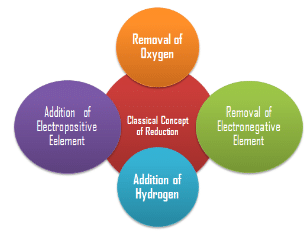 Classical Concept of Reduction
Classical Concept of Reduction
(i) Removal of Oxygen: Reduction is a chemical reaction in which oxygen is removed from any chemical species (atom, ion, or molecule).
CuO + C → Cu + CO
H2O + C → CO + H2
2CO + O2 → 2CO2
Fe3O4 + 4H2 → 3F2 + 4H2O
(ii) Addition of Hydrogen: Reduction is a chemical reaction in which hydrogen is added to any chemical species (atom, ion, or molecule).
Cl2 + H2 → 2HCl
S + H2 → H2S
C2H4 + H2 → C2H6
(iii) Removal of an Electronegative Element: Reduction is a chemical reaction in which an electronegative element is removed from any chemical species (atom, ion, or molecule). 2HgCl2 + SnCl2 → Hg2Cl2 + SnCl4 (Reduction of mercuric chlorine)
2FeCl3 + H2 → 2FeCl2 + 2HCl (Reduction of ferric chloride)
2FeCl3 + H2S → 2FeCl2 + 2HCl + S (Reduction of ferric chloride)
(iv) Addition of an Electropositive Element: Reduction is a chemical reaction in which an electropositive element is added to any chemical species (atom, ion, or molecule).
HgCl2 + Hg → Hg2Cl2 (Reduction of mercuric chloride)
CuCl2 + Cu → Cu2Cl2 (Reduction of cupric chloride)
Key Concepts
The substance that brings reduction is known as a reducing agent. A substance, which undergoes oxidation, acts as a reducing agent while a substance, which undergoes reduction, acts as an oxidizing agent.
Examples of Reducing agents: Mg, S, Cu, Na2SO3, H2S, HI, H2, C, and KI are reducing agents,
Example of Oxidising agents: O2, Cl2, F2, H2O2, MnO2, FeCl3, CuCl2, Fe3O4, CuO, etc.
- All oxidation and reduction reactions are complimentary of one another and occur simultaneously, one cannot take place without the other.
- No single oxidation and no single reduction process is known. The simultaneous oxidation and reduction reactions are generally termed redox reactions. e.g.,
- 2FeCl3 + SnCl2 → 2FeCl2 + SnCl4 or 2Fe3++ Sn2+ → 2Fe2+ + Sn4+
In above example iron undergoes reduction from +3 to +2 and tin undergoes oxidation from +2 to +4.
Modern Concept of Oxidation & Reduction
According to the modern concept, the loss of electrons is oxidation whereas the gain of electrons is reduction.

(a) Examples of oxidation reactions are:
- Na → Na+ + e-
- Zn → Zn2+ + 2e-
- Fe2+ → Fe3+ + e-
- Sn2+ → Sn4+ + 2e-
- H2O2 → O2 + 2H+ + 2e-
- 2S2O32– → S4O62– + 2e-
- [Fe(CN)6]4– → [Fe(CN)6]3– + e-
- MnO42– → MnO4– + e-
(b) Examples of reduction reactions are:
- Cl2 + 2e- → 2Cl
- S + 2e- → S2–
- Cu2+ + 2e- → Cu
- MnO4– + 8H+ + 5e-→ Mn2+ + 4H2O
- Cr2O72– + 14H+ + 6e- → 2Cr3+ + 7H2O
- H2O2 + 2H+ + 2e- → 2H2O
In a redox process, the valency of the involved species changes. The valency of a reducing agent increases while the valency of an oxidizing agent decreases in a redox reaction. The valency of a free element is taken as zero.
When there is no change in valency it means there is no oxidation or reduction, e.g.,
BaCl2 + H2SO4 → BaSO4 + 2HCl or BaSO4 → Ba2+ + SO42– (No change in valency)
Redox Reactions in Terms of Electron Transfer Reactions
We already know that the reactions:
- 2Na(s)+Cl2(g)→2NaCl(s)
- 4Na(s)+O2(g)→2Na2O(s)
- 2Na(s)+S(s)→Na2S(s)
are redox reactions because, in each case, sodium is oxidized when it combines with oxygen or a more electronegative element. At the same time, chlorine, oxygen, and sulfur are reduced because they gain electrons from sodium, an electropositive element.
From what we know about chemical bonding, sodium chloride, sodium oxide, and sodium sulfide are ionic compounds and are better represented as Na+Cl− (sodium chloride), Na+)2O2− (sodium oxide), and Na+)2S2− (sodium sulfide). The formation of these charges indicates that we can rewrite the reactions in this way to show the electron transfer more clearly.
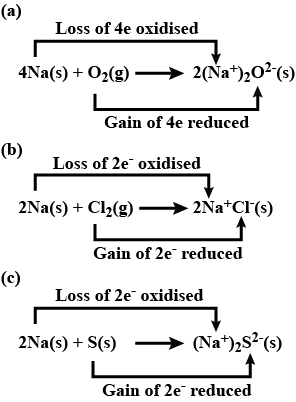
To make things simpler, let's break down the process:
Each reaction can be viewed in two parts: one part where electrons are lost and another part where electrons are gained. Let's use the formation of sodium chloride as an example:
Sodium loses electrons: 2Na(s) → 2Na+(g) + 2e−
Chlorine gains electrons: Cl2(g) + 2e− → 2Cl−(g)
These parts are called half-reactions because they show the electron transfer process. Adding these half-reactions together gives the overall reaction:
| 2Na(s) + Cl2(g) → 2Na+Cl−(s) or 2NaCl(s) |
From these examples, we see that:
- A half-reaction where electrons are lost is called an oxidation reaction.
- A half-reaction where electrons are gained is called a reduction reaction.
We now understand oxidation and reduction through the transfer of electrons. In reactions like the ones above, sodium is oxidized (loses electrons) and acts as a reducing agent because it helps other elements gain electrons. Chlorine, oxygen, and sulfur are reduced (gain electrons) and act as oxidizing agents because they take electrons from sodium.
Conclusion
Oxidation is a process in which one or more electrons are lost or the valency of the element increases.
Reduction is a process in which one or more electrons are gained or the valency of the element decreases.
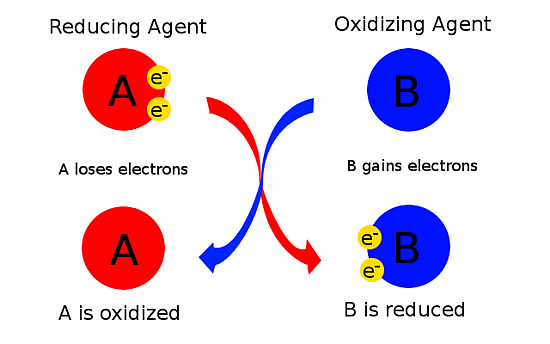 Oxidation and Reduction
Oxidation and ReductionAn oxidizing agent is a material that can gain one or more electrons, i.e., valency decreases.
A reducing agent is a material that can lose one or more electrons, i.e., valency increases.
Redox reaction involves two half-reactions, one involving loss of electrons (oxidation) and the other involving gain of electrons (reduction).
Example: Justify that the reaction: 
is a redox change.
Sol: In this reaction, the compound formed is an ionic compound, represented as

This indicates that the reaction can be split into two half-reactions:
- Sodium loses electrons:

- Hydrogen gains electrons:

By breaking the reaction into these two half-reactions, we can see that sodium is oxidized (it loses electrons) and hydrogen is reduced (it gains electrons). Therefore, the overall reaction is a redox change.
Oxidation Number
The oxidation number represents the charge a central metal atom maintains even after dissociating from all ligands attached to it. The oxidation state, or oxidation number, of an atom within a chemical compound explains the electron loss, indicating the degree of oxidation. It is a theoretical charge that an atom would carry if its bonds were entirely ionic.

- It shows the oxidation state of an element in a compound. It's determined based on a set of rules that consider the idea that in a covalent bond, the electron pair belongs completely to the more electronegative element.
- The oxidation number is defined as the charge that an atom appears to have when all other atoms are removed from it as ions. It may have a + or – sign.
- Oxidation number of an element may be a whole number (positive or negative) or fractional or zero.
Important Rules for Determining Oxidation Number
- In elements, when they are free or uncombined, each atom has an oxidation number of zero. For example, in H2, O2, Cl2, O3, P4, S8, Na, Mg, and Al, the oxidation number is zero.
- For ions with only one atom, the oxidation number equals the charge on the ion. So, Na+ has an oxidation number of +1, Mg2+ is +2, Fe3+ is +3, Cl– is –1, O2– is –2, and so on. In compounds, alkali metals always have an oxidation number of +1, alkaline earth metals have +2, and aluminum is considered +3 in all its compounds.
- Oxygen usually has an oxidation number of –2 in most compounds, but there are exceptions. In peroxides (e.g., H2O2, Na2O2), each oxygen atom has an oxidation number of –1, and in superoxides (e.g., KO2, RbO2), it's –(½). Rarely, in compounds with fluorine (e.g., OF2, O2F2), oxygen may have oxidation numbers of +2 and +1, respectively.
- Hydrogen typically has an oxidation number of +1, except when bonded to metals in binary compounds (containing two elements) like LiH, NaH, and CaH2, where its oxidation number is –1.
- Fluorine always has an oxidation number of –1 in its compounds. Other halogens (Cl, Br, I) also have –1 as oxidation numbers when they appear as halide ions. However, when combined with oxygen, for instance, in oxoacids and oxoanions, chlorine, bromine, and iodine may have positive oxidation numbers.
- The sum of oxidation numbers of all atoms in a compound must be zero. In a polyatomic ion, the sum of oxidation numbers of its atoms equals the charge on the ion. For example, in the carbonate ion (CO3)2–, the sum of oxidation numbers for three oxygen atoms and one carbon atom must equal –2.
Stock Notation
- The oxidation states of elements exhibiting variable oxidation states are specified by Roman numerals such as I, II, III, IV, etc., within parenthesis after the symbol or name of the element.
- This system was introduced for the first time by a German chemist, Alfred Stock, and is known as Stock notation. This may be illustrated as:
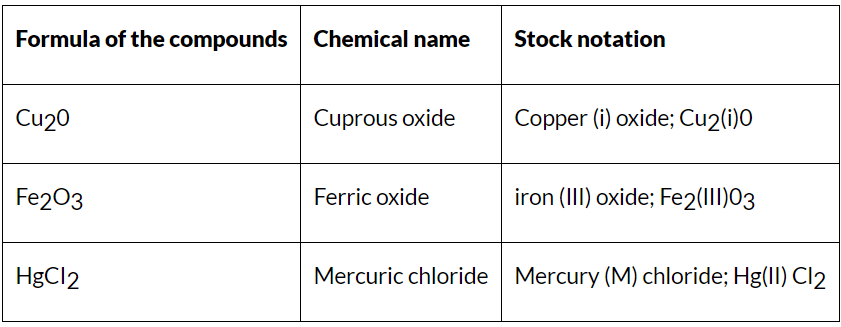 Some Examples of Stock Notation
Some Examples of Stock Notation
Solved Examples
Example: What is the oxidation state of sulphur in H2SO4 and H2SO5?
Solution: (i) H2SO4: Since there is no overall charge on the compound the oxidation states must cancel out. Although the oxidation state of hydrides is +1, there are two in the compound that must be accounted for. The same is true for oxygen; although the oxidation number of oxygen is -2, there are four oxygens present accounting for a total of -8. The +2 state contribution from the hydrides and -8 from the oxygens results in a -6 charge. The oxidation state on sulphur must be +6 for the molecule to be neutral.
 Structure of Sulphuric Acid
Structure of Sulphuric Acid
(ii) H2SO5: the oxidation number of S is +6 in H2SO5 due to the presence of a peroxy linkage bond in the molecule.
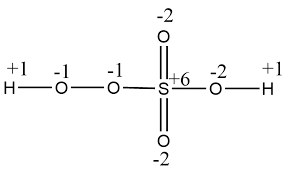 Structure of Caro's Acid
Structure of Caro's Acid
Example: What is the Oxidation Number of Nitrogen in Ammonium Nitrate i.e. NH4NO3?
Solution: The steps to find the Oxidation Number of Nitrogen in Ammonium Nitrate are:
- Split the molecule into two ions: Ammonium ion (NH4+) and Nitrate ion (NO3–).
- Determine the oxidation number of Nitrogen in each ion, denoted as X.
- For the Ammonium ion, where the overall charge is +1, set up the equation X + 4(+1) = +1.
- Solve the equation: X + 4 = 1 ⇒ X = -3.
- In the case of the nitrate ion, where the overall charge is -1 and oxygen has an oxidation number of -2, set up the equation X + 3(-2) = -1.
- Solve the equation: X – 6 = -1 ⇒ X = +5.
Therefore, the oxidation number of Nitrogen in ammonium nitrate is -3 and +5.
Example: Determine the oxidation number of each element in the following compounds:
(a) BaO2 (b) (NH4)2MoO4 (c)Na3Co(NO2)6 (d) CS2
Solution: (a) If oxygen in BaO2 had an oxidation number of -2, then barium would need to have an oxidation number of +4. However, elements in Group IIA, like barium, can't have a +4 oxidation state. This compound must be barium peroxide, [Ba2+][O22-]. Therefore, barium is +2 and oxygen is -1.
(b) In (NH4)2MoO4, the NH4+ ion has hydrogen at +1 and nitrogen at -3. With two NH4+ ions, the other part must be an MoO42- ion, where molybdenum is -6 and oxygen is -2.
(c) Sodium always has an oxidation state of +1 in its compounds. This compound contains the Co(NO2)63- complex ion, with six NO2- ions where nitrogen is +3 and oxygen is -2. The oxidation state of cobalt is thus +3.
(d) The most electronegative element in a compound always has a negative oxidation number. Since sulphur typically forms -2 ions, the oxidation number of sulphur in CS2 is -2, and carbon is +4.
Example: Calculate the oxidation number of nitrogen (N) in NO.
Solution: The oxidation state of oxygen(O) = -2
Consider the oxidation state of nitrogen(N) = x
Now, x-2 = 0 => x = +2
Hence, the oxidation number of N in NO is +2.
Example: Calculate the oxidation number of sulphur (S) in sulphuric acid:H2SO4
Solution: The oxidation state of oxygen(O) = -2
The oxidation state of hydrogen(H) = +1
Consider the oxidation state of sulphur (S) = X
Now,
2(+1)+X+(−22(+1)+X +(−2×4)
−2+X+8=0
X = +6
Hence, the oxidation number for sulphur in sulphuric acid is +6.
Example: Find oxidation number of Cr2 in the formula K2Cr2O7
Solution: K2= +2; O7= (-2 × 7); Cr2= 2 × x
Therefore, 2+ 2x-14=0. Thus x=+6 (Oxidation state of chromium)
Example: Find oxidation state of N in the formula NH4NO3
Solution: There are two different nitrogen atoms in the compound. Therefore we need to do the calculation separately
In NH+4, or X +4 (+1) = +1
Therefore x= -3 (Oxidation state in NH+4). The oxidation state of N in NO–3
y+3 × (-2)= -1
y= +6-1 =5
Uses of Redox Reactions
- These reactions play a crucial role in many physical and biological processes.
- They are widely used in pharmaceuticals, biology, industry, metallurgy, and agriculture.
- Their significance is evident in activities like burning fuels for energy, extracting metals through electrochemical processes, making chemicals like caustic soda, operating batteries, and dealing with metal corrosion.
- Recently, environmental concerns like the Hydrogen Economy (using liquid hydrogen as fuel) and the formation of the 'Ozone Hole' are also connected to redox processes.
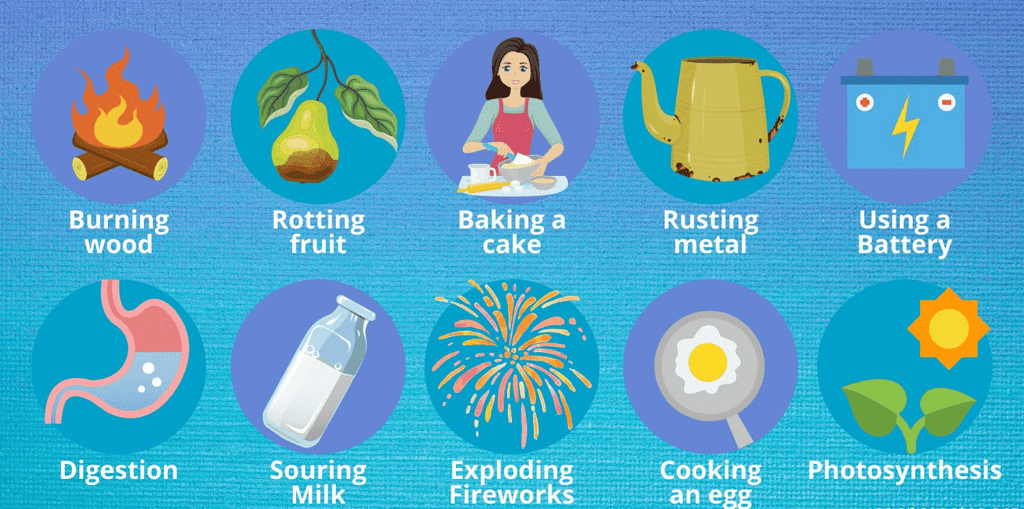 Some Examples of Redox Reactions in Daily Life
Some Examples of Redox Reactions in Daily Life
|
90 videos|490 docs|209 tests
|
FAQs on Redox Reactions: Oxidation & Reduction, Oxidation Number - Science & Technology for UPSC CSE
| 1. What are redox reactions? |  |
| 2. What is the classical concept of oxidation and reduction? |  |
| 3. How are redox reactions explained in terms of electron transfer reactions? |  |
| 4. What is an oxidation number and how is it determined? |  |
| 5. What is Stock notation and how is it used in redox reactions? |  |






















